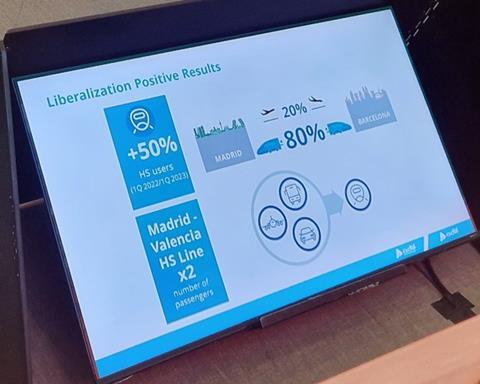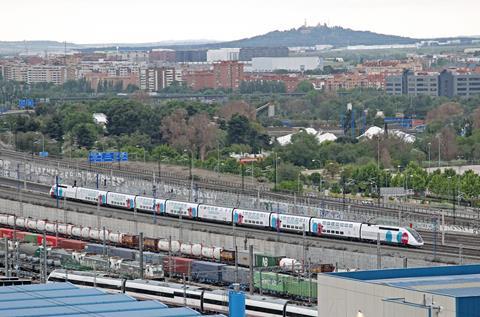
SPAIN: Infrastructure manager ADIF has put forward proposals for the expansion of open access operations across the Spanish rail network, building on the experience of competition on selected high speed lines.
Speaking at the UNIFE General Assembly in Madrid on June 15, ADIF President María Domínguez-González presented statistics showing that since the start of the liberalisation process on Spanish long-distance rail routes, overall passenger volumes had grown by 50%, while the Madrid – Valencia high speed line had seen twice as many passengers use it in Q1 2023 compared to the same period in 2022.
She also highlighted that rail now has an 80% share of the rail-air market on the famous ‘air bridge’ route between Madrid and Barcelona. According to competition regulator CNMC’s most recent data, the number of passengers on the Madrid – Barcelona artery in the first three months of 2023 had increased by 57% on a year-on-year basis, with close to 2 million journeys being made.
More liberalisation to come

Addressing an earlier meeting in Madrid on May 29, organised by CNMC, Domínguez-González said ‘a second phase of liberalisation’ was about to start, enabling new entrants Iryo and Ouigo to expand their range of services beyond the three arteries linking Madrid to Catalunya, Levante and Andalucía, for which both have a 10-year capacity allocation.
‘The Spanish market is no longer a monopolistic one, and there is great interest among both the existing open access operators and potential future ones in providing services on other lines’, she explained. ‘If anything, it is likely that competition, as regards services and routes, will be more selective.’
Domínguez-González said ADIF needed to establish priorities that would enable new operators to have access to the conventional network. However, two factors have to be taken into consideration. One is the available capacity at hub stations, although those at Madrid-Chamartín, Barcelona-Sants and València are already being expanded. The other is track gauge. So far both Ouigo and Iryo have been able to use 1 435 mm gauge trainsets, but expansion to northern and northwestern Spain or Extremadura would require the use of variable-gauge trains.
Some form of hybrid traction would be needed to operate on non-electrified routes to destinations such as Ferrol and Cartagena, with batteries and hydrogen fuel cells being cited as possible options. The construction and authorisation of new trains meeting these requirements would take time and represent a significant investment.
Both Iryo and Ouigo were represented at the meeting, along with state-owned operator Renfe, ADIF, CNMC and the European Commission.
Access charge reforms

Although the liberalisation of high speed services has been regarded as successful in terms of increasing rail ridership and market share, the two new operators regard the access charges imposed by ADIF as excessive.
Confirming her interest in operating new routes linking Madrid with Segovia, Valladolid, Elx and Murcia, Ouigo Director-General Hélène Valenzuela, observed that ADIF’s access charges were ‘obsolete’ and urged immediate action by the European Commission. Iryo’s Simone Gorini agreed, fearing that the high access charges would affect the profitability of operating high speed services.
Renfe Viajeros Director Sonia Araújo noted that access charges had been reduced in response to the pandemic and loss of traffic, and she hoped that this reduction would continue during the coming years. Charges are currently frozen for the whole of 2023.
ADIF’s response was that reforms to the national Railway Act only took place in December 2022, and that time would be needed to review access charges. Citing data supplied by CNMC, the infrastructure manager asserted that the charges were no higher than those in force in France or Italy, and should not be regarded as excessive.
The legislative changes envisage that access charges will be restructured to reflect the wear and tear caused by various types of train, and to enable the infrastructure manager to adjust them to encourage more efficient use of the network.
CNMC President Cani Fernández observed that Spain was well ahead of both France and Germany in opening the long distance rail market to new operators, and that the Spanish reforms were opening up high speed rail travel to those sectors of the travelling public who were hitherto unable to afford it.
Fernández also noted the operators’ concerns about the rising cost of electric energy for traction. Both Ouigo and Iryo complained that the Spanish government had not given consideration to train operators regarding the recent massive increases in energy prices, as had been done for other users of fossil fuels and electricity. Renfe suggested that operators should be able to participate in tendering for the purchase of energy, while Ouigo felt that ADIF should aim to place long term contracts for the supply of traction power, reducing the uncertainty for operators caused by short-term contracts.

















